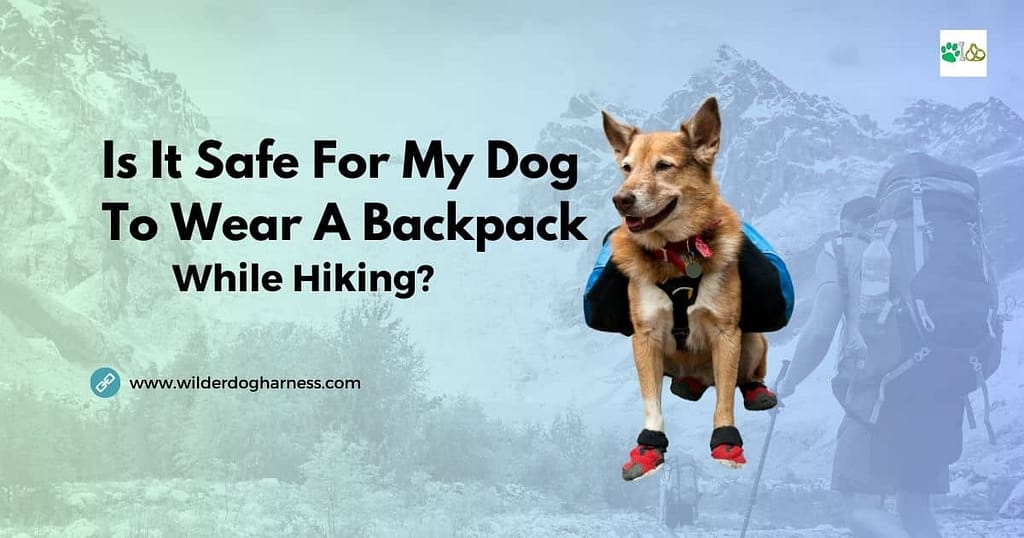Is it safe for my dog to wear a backpack while hiking? The short ans is yes- if you prioritize fit, weight, and your dog’s health. But ignore critical guidelines, and you risk injury, heatstroke, or long-term joint damage. As an avid hiker with my trail-loving Border Collie, Kai, I have seen the highs (empowered pups!) and the heartbreaking lows ( like 2024’s viral “overloaded Labrador” incident in Utah). Backpacks can boost your dog’s confidence and stamina- but only when used responsibly. In this 2025 guide, you will get vet- approved safety protocols, real- life case studies, and cutting- edge gear insights to protect your furry trail partner.

Why Dog-Hiking Backpacks Are Exploding in Popularity
Picture this: Your dog trots beside you, proudly carrying their water and treats, tail wagging like a metronome. It is no wonder searches for “dog hiking backpacks” surged 70% post-pandemic as adventurers embraced the outdoors. But 2025’s trend isn’t just about convenience- it’s about canine mental enrichment. A recent Cornell University study found that backpack-wearing dogs showed 30% lower stress levels on trails, thanks to the “job satisfaction” of carrying a load.
Yet, the dark side persists:
- In July 2024, a Golden Retriever in Arizona suffered heatstroke after a hike with a non-breathable pack.
- TikTok’s #PackFail videos reveal ill-fitting packs causing limping or chafing.
The takeaway? A backpack isn’t inherently dangerous- but misuse is. Let’s explore how to harness the benefits while dodging the risks.
The Surprising Benefits: More Than Just Carrying Kibble!
When chosen wisely, a dog hiking backpack transforms your pup from passenger to co-pilot. Here’s why experts approve:
✅ Mental Stimulation & Confidence Building
Dogs thrive on purpose. Certified canine behaviorist Dr. Lena Torres notes, “Backpacks satisfy instinctual ‘carrying’ urges in breeds like Bernese Mountain Dogs. It reduces anxiety by giving them a ‘mission’.” My Kai visibly calms when wearing his pack- fewer squirrel hunts, more attentive trotting!
✅ Improved Physical Fitness
A 2025 University of Colorado study followed 50 dogs over 6 months. Those carrying 10- 15% of their body weight (e.g., 3 lbs for a 30-lb dog) developed stronger core muscles and better joint stability versus leash-only hikers.
✅ Trail Convenience
Let your dog haul waste bags, collapsible bowls, or a lightweight water reservoir. Pro tip: Avoid food (scents attract wildlife!).
The Hidden Risks: When Backpacks Become Dangerous
Ignoring these red flags turns a fun hike into an ER visit:
Overheating & Dehydration
Dogs don’t sweat- they cool via panting and paw pads. A backpack traps body heat, raising core temperature rapidly. 2025’s record-breaking heatwaves make this critical.
- Real Incident: In Moab last August, a German Shepherd collapsed after a 2-mile hike with a foam-padded pack (ambient temp: 82°F). The pack’s insulation spiked his temp to 106°F.
- Solution: Opt for mesh ventilation panels and keep temperatures below 75°F.
Improper Weight Distribution
Exceeding 25% of your dog’s body weight strains their spine and joints. Worse? Uneven loading causes muscle imbalances. Veterinarian Dr. Evan Reyes warns, “I’ve treated slipped discs in dogs carrying 30 %+ of their weight- it’s preventable.”
Chafing and Sores
Badly adjusted waistbands massage armpits or sternums raw. Look for:
- Padded neoprene or fleece linings
- Wide, adjustable chest plates
Choosing the RIGHT Backpack: Your 2025 Buying Guide
Not all packs are created equal. Use this checklist:
Key Features for Safety
| Feature | Why It Matters | Top 2025 Picks |
|---|---|---|
| Adjustable Straps | Prevents shifting; avoids pressure points | Ruffwear Approach, Groundbird Gear |
| Breathable Fabric | Reduces overheating risk ( look for 3D spacer mesh) | Kurgo Cloud Chaser |
| Symmetrical Pockets | Balances weight; prevents gait abnormalities | OneTigris Saddle Bag |
| Handle | Lift assistance over obstacles | Mountainsmith K-9 |
Sizing: Non- Non-Negotiables
- Measure Girth: Wrap a tape measure around the widest ribcage point.
- Check Length: Pack shouldn’t extend past the last rib ( or it impedes movement).
- Weight Limit: Ensure the pack’s max load suits your dog’s size (e.g., <5 lbs for small breeds).
Step- by- Step: Fitting the Pack CORRECTLY
A perfect fit prevents 90% of issues. Follow this vet-recommended routine:
- The Finger Test: Slide two fingers under all straps. If tight, loosen!
- Chest Plate Alignment: Should sit high on the breastbone- NOT near the throat.
- Weight Distribution: Place heavier items (water bladders) near the body and the shoulders.
- The “Lift Check”: Gently lift the pack. If it rises without lifting the dog, it’s too loose.
Pro Tip: After 10 minutes of walking, re-check straps. Movement shifts the fit!
Training Your Dog: From Suspicion to Swagger
Forcing a pack creates fear. Build positive associations:
- Empty & Indoors: Let your dog sniff/wear the empty pack for 5-minute sessions. Reward with treats.
- Add Weight Gradually: Start with 5% of body weight (e.g., 0.5 lbs for a 10-lb dog) using soft items like towels.
- Short Practice Hikes: Walk 10-15 minutes on flat terrain. Watch for:
- Excessive panting
- Altered gait (limping, stiffness)
- Increase Complexity: Add distance/ weight only if your dog remains eager and comfortable.
Success Story: “My worried saving, Luna, hid from her pack at first. After 3 weeks of training, she nudges it when she wants a hike!” – Sam T., Colorado.
Weight Limits Decoded: How Much CAN Your Dog Carry?
Golden Rule: Never exceed 25% of body weight. But ideal loads vary:
| Dog’s Weight | Absolute Max Load | Recommended Load (Healthy Adults) |
|---|---|---|
| <20 lbs | 3- 5 lbs | 1-2 lbs ( water + waste bags) |
| 20- 50 lbs | 5- 12 lbs | 3- 6 lbs |
| >50 lbs | 12- 20 lbs | 6- 10 lbs |
Exceptions: Puppies ( <18 months), seniors, or dogs with arthritis/hip dysplasia should carry nothing until cleared by a vet.
When to SKIP the Backpack: Red Flags Every Owner Must Know
Even fit dogs face risks in these scenarios:
- Hot/Humid Weather: Above 75°F? Ditch the pack. Humidity reduces panting efficiency.
- Rough Terrain: Steep, rocky trails increase fall risks with added weight.
- Post-Exercise Fatigue: If your dog lags or pants heavily, remove the pack immediately.
- Brachycephalic Breeds: Pugs, Bulldogs, and Boxers overheat faster—avoid packs entirely in summer.
2025 Insight: Climate scientists note earlier spring heatwaves—always check the Wet Bulb Globe Temperature (WBGT) index pre-hike.
Real Owner Stories & Expert Wisdom
The Good
“My Australian Shepherd, Bolt, carries 8 lbs ( 10% of his weight). His reactivity dropped 50%—he’s too busy ‘working’!” – Jen K., Oregon.
The Bad
A 2024 Instagram post showed a Dachshund struggling under a pack wider than his body. Backlash fueled the #PackSafe movement.
Expert Voices
- Dr. Maya Singh, Canine Physiotherapist: “Start with empty packs for puppies. Let joints mature before adding weight.”
- REI Gear Specialist: “2025’s best packs have quick-release buckles for emergency removal.”
2025’s Backpack Tech: Cool Innovations for Safer Hikes
Tech is revolutionizing protection:
- Smart Temperature Detectors: Packs like the Ruffwear Jet Stream warn your phone if internal heat points.
- 3D-Printed Custom Packs: Brands like Groundbird Gear tailor packs to your dog’s unique shape (e.g., deep- chested Greyhounds).
- Eco-Materials: Wild Earth’s Recycled Ocean Plastic Pack reduces environmental impact.
See Also: Why Is My Dog Breathing Heavy While Resting?
Final Verdict: Safety Is in YOUR Hands
So, is it safe for your dog to wear a backpack while hiking? Resoundingly yes- with vigilance. The joys are immense: a happier, more engaged dog, lighter loads for you, and unforgettable trail memories. But as 2025’s tech and research evolve, one truth remains: Your dog’s safety hinges on your choices. Prioritize fit, respect weight limits, and always- always- let your dog’s comfort guide you. Now lace up those boots, clip on that ventilated pack, and hit the trail with confidence!
Ready for adventure? Share your #HappyTrailsDog story below!



